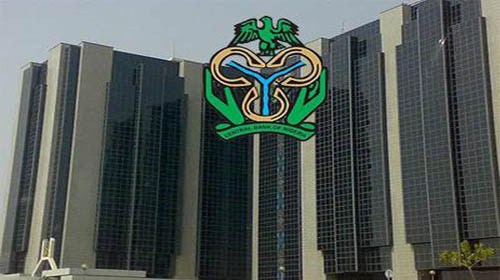There are indications that banks borrowing from the Central Bank of Nigeria (CBN) may hit N23.7 trillion by end of this year, with interest payment of N15 billion going by the current thrust and impacts of the CBN monetary measures.
This represents 109 percent and 86 percent increases against the N11.33 trillion and N8.4 billion recorded in 2018.
The development would be fuelled by the apex bank’s contractionary monetary policy stance in the face of the increasing pressure on the Naira in the Investors and Exporters (I&E) window.
The pressure in the I&E is being triggered by sharp decline in foreign portfolio inflows and increased dollar demand by foreign portfolio investors, FPIs, exiting the nation’s money market.
Furthermore, banks’ deposit placements with the CBN is expected to drop by 31 percent to N14.3 trillion from N20.7 trillion in 2018 with interest earned by the banks rising moderately by 2.69 percent to N7.23 billion from N7.5 billion in 2018.
READ ALSO: JUST IN: Popular Lagos market, Katangowa on fire
Indications to this emerged from the CBN monthly economic reports covering January to May 2019, which showed that banks’ borrowing from the CBN through the Standing Lending Facility (SLF) shot up by 109 percent to N10.99 trillion for the five months period, from N5.27 trillion during the corresponding period (January to May) of 2018. Interest paid by the banks also shot up by 86 percent to N7.32 billion during the five months period ending May 2019, from N3.94 trillion in the corresponding period of 2018.
The CBN monthly economic reports also showed that banks’ deposit placement with the CBN through its Standing Deposit Facility (SDF) dropped by 31 percent to N5.59 trillion during the period under review from N8.1 trillion in the corresponding period of 2018, while the interest earned by banks rose slightly by N2.85 billion from N2.69 billion in the corresponding period of 2018.
The above trend is expected to persist till the end of the year driven by two factors, namely, the recent reduction in the remunerable limit on banks’ deposit placement through the SDF, and scarcity of funds in the interbank money market, due to increased liquidity mop up by the CBN.
The mop up, Financial Vanguard learnt, became compelling to address increasing pressure on the Naira due to sharp decline in foreign portfolio investment (FPI) inflows and increased dollar demand on the CBN.
Pressure on the Naira
Analysis showed that the Naira lost 0.7 percent or N2.87 against the dollar between July 1 and August 9 in the I&E window, where the indicative exchange rate rose to N363.57 per dollar on August 9 from N360.57 per dollar on July 1.
This is in sharp contrast to the relative stability of the currency in the first half of the year (H1’19) when the indicative exchange rate for the I&E hovered between N360 per dollar and N361 per dollar.
Analysis shows that FPI inflow in the I&E dropped by 28 percent to $780 million in July, the lowest since December 2018. The figure was $1.09 billion in June 2019.
The $780 million FPI inflow for July represented 60 percent decline when compared with average monthly inflow of $1.94 billion in H1’19.
This development forced the CBN to intervene in the I&E window for the first time since April this year, injecting $540 million.
Furthermore, the apex bank increased liquidity mop up in the interbank money market by 36 percent, as it sold N739 billion worth of secondary market Treasury Bills, TBs, (Open Market Operations, OMO) in July, up from N476 billion sold in June.
This action resulted to net outflow of N438 billion through OMO bills from the interbank money market in July, up from net outflow of N4 billion in June.
Analysts’ comments
Financial analysts have been busy tracking these developments recently. According to Nnamdi Olisaeloka, a Fixed Income Analysts with Lagos based investment firm, Zedcrest Capital Limited, the development will be repeated in the remaining period of 2019, especially in the face of N9.6 trillion worth of TBs which will mature between August and December this year, hence increased borrowing by banks from the apex bank.
READ ALSO: Police arrest 2 female cultists, 6 others during initiation
He said: “We expect the trend of higher SLF figures to persist in the remaining months of 2019, as the CBN is expected to increase its spate of Open Market Operations (OMO) issuance and foreign exchange interventions in the interbank market, to combat the higher OMO maturity profile in September to December 2019 and to sustain the stability of the naira, given the recent pressures from capital flow reversals by offshore investors.
Banking system liquidity
Also the CBN policy on sterilizing excess funds of banks operating below its 60 percent Loan to Deposit (LDR) benchmark ratio, would also impact on banking system liquidity and could pressure the SLF volumes higher.”
However, Ayo Akinwunmi, Head of Research, FSDH Merchant Bank, though attributed the sharp increase in SLF to increase in banks’ lending to the economy, argued that the trend might not persist in the remaining part of the year.
He said: “I am aware that banks are expanding lending to the real sector of the economy and they are mobilising fund from various sources, including borrowing money from the Central Bank of Nigeria, to meet the increasing lending requirements.
“The trend of higher SDF may not continue because of the huge liquidity in excess of N9.6 trillion that is coming to the inter-bank market from August to December 2019 in form of maturities of government securities.”
Both analysts, however, agree that the sharp decline in SDF will persist for the remaining part of the year due to the decision of the CBN to reduced the remunerable limit on banks’ deposit placement through the SDF to N2 billion per day from N7 billion per day.
According to Olisaeloka, “The SDF figure is expected to sustain a decline as banks would prefer to invest their surplus funds in short term treasury bills, given the decline in the remunerable SDF amount to N2 billion per institution.”
Akinwunmi on his part said: “Since the amount that will qualify for interest rate at the Standing Deposit Facility has dropped from N7. 5 billion to N2 billion in the face of an increase in minimum loan to deposit ratio, less fund will be available for SDF.
This is because banks are now required to channel more fund to lending than before, to stimulate economic growth in Nigeria. (TheSun)


